Ran Tao
Agent Bain vs. Agent McKinsey: A New Text-to-SQL Benchmark for the Business Domain
Oct 08, 2025Abstract:In the business domain, where data-driven decision making is crucial, text-to-SQL is fundamental for easy natural language access to structured data. While recent LLMs have achieved strong performance in code generation, existing text-to-SQL benchmarks remain focused on factual retrieval of past records. We introduce CORGI, a new benchmark specifically designed for real-world business contexts. CORGI is composed of synthetic databases inspired by enterprises such as Doordash, Airbnb, and Lululemon. It provides questions across four increasingly complex categories of business queries: descriptive, explanatory, predictive, and recommendational. This challenge calls for causal reasoning, temporal forecasting, and strategic recommendation, reflecting multi-level and multi-step agentic intelligence. We find that LLM performance drops on high-level questions, struggling to make accurate predictions and offer actionable plans. Based on execution success rate, the CORGI benchmark is about 21\% more difficult than the BIRD benchmark. This highlights the gap between popular LLMs and the need for real-world business intelligence. We release a public dataset and evaluation framework, and a website for public submissions.
VMDNet: Time Series Forecasting with Leakage-Free Samplewise Variational Mode Decomposition and Multibranch Decoding
Sep 18, 2025Abstract:In time series forecasting, capturing recurrent temporal patterns is essential; decomposition techniques make such structure explicit and thereby improve predictive performance. Variational Mode Decomposition (VMD) is a powerful signal-processing method for periodicity-aware decomposition and has seen growing adoption in recent years. However, existing studies often suffer from information leakage and rely on inappropriate hyperparameter tuning. To address these issues, we propose VMDNet, a causality-preserving framework that (i) applies sample-wise VMD to avoid leakage; (ii) represents each decomposed mode with frequency-aware embeddings and decodes it using parallel temporal convolutional networks (TCNs), ensuring mode independence and efficient learning; and (iii) introduces a bilevel, Stackelberg-inspired optimisation to adaptively select VMD's two core hyperparameters: the number of modes (K) and the bandwidth penalty (alpha). Experiments on two energy-related datasets demonstrate that VMDNet achieves state-of-the-art results when periodicity is strong, showing clear advantages in capturing structured periodic patterns while remaining robust under weak periodicity.
On Minimization/Maximization of the Generalized Multi-Order Complex Quadratic Form With Constant-Modulus Constraints
Aug 27, 2025Abstract:In this paper, we study the generalized problem that minimizes or maximizes a multi-order complex quadratic form with constant-modulus constraints on all elements of its optimization variable. Such a mathematical problem is commonly encountered in various applications of signal processing. We term it as the constant-modulus multi-order complex quadratic programming (CMCQP) in this paper. In general, the CMCQP is non-convex and difficult to solve. Its objective function typically relates to metrics such as signal-to-noise ratio, Cram\'er-Rao bound, integrated sidelobe level, etc., and constraints normally correspond to requirements on similarity to desired aspects, peak-to-average-power ratio, or constant-modulus property in practical scenarios. In order to find efficient solutions to the CMCQP, we first reformulate it into an unconstrained optimization problem with respect to phase values of the studied variable only. Then, we devise a steepest descent/ascent method with fast determinations on its optimal step sizes. Specifically, we convert the step-size searching problem into a polynomial form that leads to closed-form solutions of high accuracy, wherein the third-order Taylor expansion of the search function is conducted. Our major contributions also lie in investigating the effect of the order and specific form of matrices embedded in the CMCQP, for which two representative cases are identified. Examples of related applications associated with the two cases are also provided for completeness. The proposed methods are summarized into algorithms, whose convergence speeds are verified to be fast by comprehensive simulations and comparisons to existing methods. The accuracy of our proposed fast step-size determination is also evaluated.
Cross-domain Hyperspectral Image Classification based on Bi-directional Domain Adaptation
Jul 03, 2025Abstract:Utilizing hyperspectral remote sensing technology enables the extraction of fine-grained land cover classes. Typically, satellite or airborne images used for training and testing are acquired from different regions or times, where the same class has significant spectral shifts in different scenes. In this paper, we propose a Bi-directional Domain Adaptation (BiDA) framework for cross-domain hyperspectral image (HSI) classification, which focuses on extracting both domain-invariant features and domain-specific information in the independent adaptive space, thereby enhancing the adaptability and separability to the target scene. In the proposed BiDA, a triple-branch transformer architecture (the source branch, target branch, and coupled branch) with semantic tokenizer is designed as the backbone. Specifically, the source branch and target branch independently learn the adaptive space of source and target domains, a Coupled Multi-head Cross-attention (CMCA) mechanism is developed in coupled branch for feature interaction and inter-domain correlation mining. Furthermore, a bi-directional distillation loss is designed to guide adaptive space learning using inter-domain correlation. Finally, we propose an Adaptive Reinforcement Strategy (ARS) to encourage the model to focus on specific generalized feature extraction within both source and target scenes in noise condition. Experimental results on cross-temporal/scene airborne and satellite datasets demonstrate that the proposed BiDA performs significantly better than some state-of-the-art domain adaptation approaches. In the cross-temporal tree species classification task, the proposed BiDA is more than 3\%$\sim$5\% higher than the most advanced method. The codes will be available from the website: https://github.com/YuxiangZhang-BIT/IEEE_TCSVT_BiDA.
Transforming Weather Data from Pixel to Latent Space
Mar 09, 2025Abstract:The increasing impact of climate change and extreme weather events has spurred growing interest in deep learning for weather research. However, existing studies often rely on weather data in pixel space, which presents several challenges such as smooth outputs in model outputs, limited applicability to a single pressure-variable subset (PVS), and high data storage and computational costs. To address these challenges, we propose a novel Weather Latent Autoencoder (WLA) that transforms weather data from pixel space to latent space, enabling efficient weather task modeling. By decoupling weather reconstruction from downstream tasks, WLA improves the accuracy and sharpness of weather task model results. The incorporated Pressure-Variable Unified Module transforms multiple PVS into a unified representation, enhancing the adaptability of the model in multiple weather scenarios. Furthermore, weather tasks can be performed in a low-storage latent space of WLA rather than a high-storage pixel space, thus significantly reducing data storage and computational costs. Through extensive experimentation, we demonstrate its superior compression and reconstruction performance, enabling the creation of the ERA5-latent dataset with unified representations of multiple PVS from ERA5 data. The compressed full PVS in the ERA5-latent dataset reduces the original 244.34 TB of data to 0.43 TB. The downstream task further demonstrates that task models can apply to multiple PVS with low data costs in latent space and achieve superior performance compared to models in pixel space. Code, ERA5-latent data, and pre-trained models are available at https://anonymous.4open.science/r/Weather-Latent-Autoencoder-8467.
LWFNet: Coherent Doppler Wind Lidar-Based Network for Wind Field Retrieval
Jan 05, 2025



Abstract:Accurate detection of wind fields within the troposphere is essential for atmospheric dynamics research and plays a crucial role in extreme weather forecasting. Coherent Doppler wind lidar (CDWL) is widely regarded as the most suitable technique for high spatial and temporal resolution wind field detection. However, since coherent detection relies heavily on the concentration of aerosol particles, which cause Mie scattering, the received backscattering lidar signal exhibits significantly low intensity at high altitudes. As a result, conventional methods, such as spectral centroid estimation, often fail to produce credible and accurate wind retrieval results in these regions. To address this issue, we propose LWFNet, the first Lidar-based Wind Field (WF) retrieval neural Network, built upon Transformer and the Kolmogorov-Arnold network. Our model is trained solely on targets derived from the traditional wind retrieval algorithm and utilizes radiosonde measurements as the ground truth for test results evaluation. Experimental results demonstrate that LWFNet not only extends the maximum wind field detection range but also produces more accurate results, exhibiting a level of precision that surpasses the labeled targets. This phenomenon, which we refer to as super-accuracy, is explored by investigating the potential underlying factors that contribute to this intriguing occurrence. In addition, we compare the performance of LWFNet with other state-of-the-art (SOTA) models, highlighting its superior effectiveness and capability in high-resolution wind retrieval. LWFNet demonstrates remarkable performance in lidar-based wind field retrieval, setting a benchmark for future research and advancing the development of deep learning models in this domain.
Task-Parameter Nexus: Task-Specific Parameter Learning for Model-Based Control
Dec 17, 2024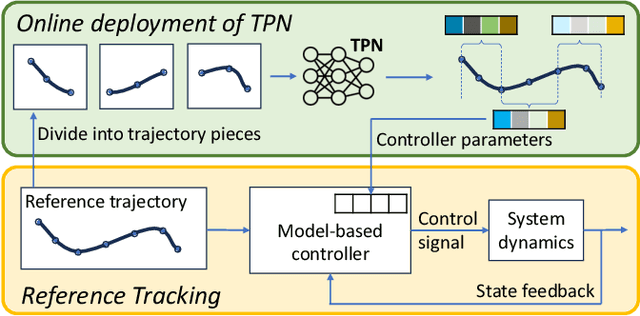
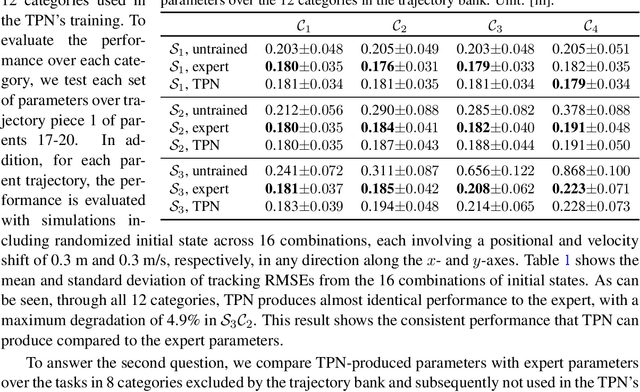
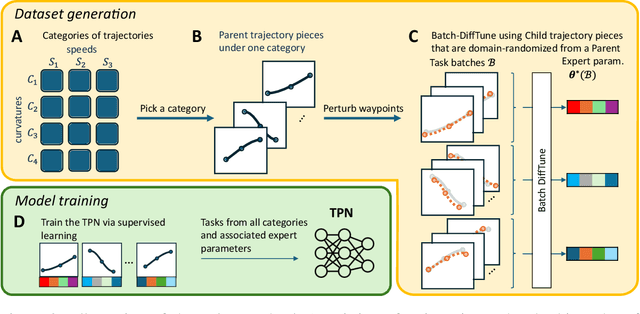
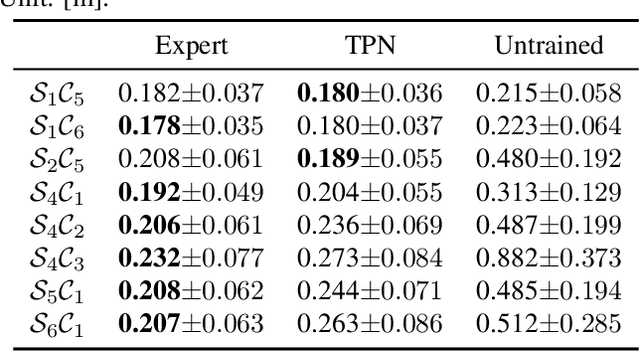
Abstract:This paper presents the Task-Parameter Nexus (TPN), a learning-based approach for online determination of the (near-)optimal control parameters of model-based controllers (MBCs) for tracking tasks. In TPN, a deep neural network is introduced to predict the control parameters for any given tracking task at runtime, especially when optimal parameters for new tasks are not immediately available. To train this network, we constructed a trajectory bank with various speeds and curvatures that represent different motion characteristics. Then, for each trajectory in the bank, we auto-tune the optimal control parameters offline and use them as the corresponding ground truth. With this dataset, the TPN is trained by supervised learning. We evaluated the TPN on the quadrotor platform. In simulation experiments, it is shown that the TPN can predict near-optimal control parameters for a spectrum of tracking tasks, demonstrating its robust generalization capabilities to unseen tasks.
CROPS: A Deployable Crop Management System Over All Possible State Availabilities
Nov 09, 2024



Abstract:Exploring the optimal management strategy for nitrogen and irrigation has a significant impact on crop yield, economic profit, and the environment. To tackle this optimization challenge, this paper introduces a deployable \textbf{CR}op Management system \textbf{O}ver all \textbf{P}ossible \textbf{S}tate availabilities (CROPS). CROPS employs a language model (LM) as a reinforcement learning (RL) agent to explore optimal management strategies within the Decision Support System for Agrotechnology Transfer (DSSAT) crop simulations. A distinguishing feature of this system is that the states used for decision-making are partially observed through random masking. Consequently, the RL agent is tasked with two primary objectives: optimizing management policies and inferring masked states. This approach significantly enhances the RL agent's robustness and adaptability across various real-world agricultural scenarios. Extensive experiments on maize crops in Florida, USA, and Zaragoza, Spain, validate the effectiveness of CROPS. Not only did CROPS achieve State-of-the-Art (SOTA) results across various evaluation metrics such as production, profit, and sustainability, but the trained management policies are also immediately deployable in over of ten millions of real-world contexts. Furthermore, the pre-trained policies possess a noise resilience property, which enables them to minimize potential sensor biases, ensuring robustness and generalizability. Finally, unlike previous methods, the strength of CROPS lies in its unified and elegant structure, which eliminates the need for pre-defined states or multi-stage training. These advancements highlight the potential of CROPS in revolutionizing agricultural practices.
STANet: A Novel Spatio-Temporal Aggregation Network for Depression Classification with Small and Unbalanced FMRI Data
Jul 31, 2024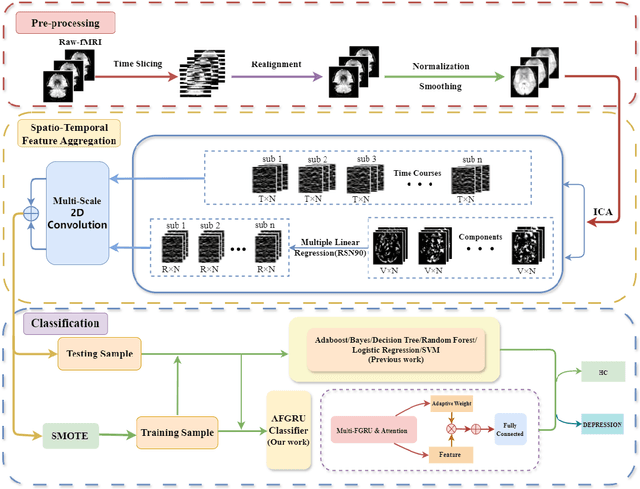
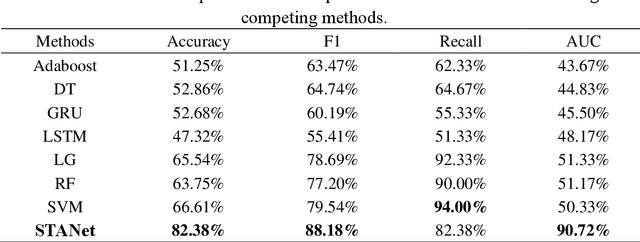
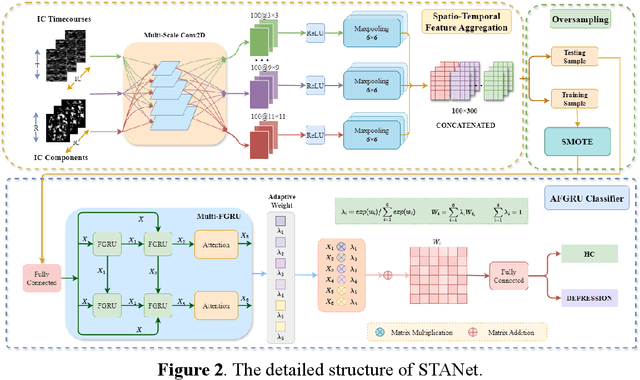
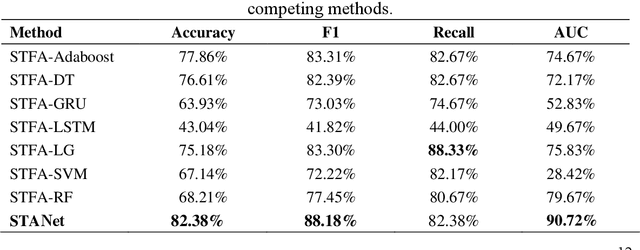
Abstract:Accurate diagnosis of depression is crucial for timely implementation of optimal treatments, preventing complications and reducing the risk of suicide. Traditional methods rely on self-report questionnaires and clinical assessment, lacking objective biomarkers. Combining fMRI with artificial intelligence can enhance depression diagnosis by integrating neuroimaging indicators. However, the specificity of fMRI acquisition for depression often results in unbalanced and small datasets, challenging the sensitivity and accuracy of classification models. In this study, we propose the Spatio-Temporal Aggregation Network (STANet) for diagnosing depression by integrating CNN and RNN to capture both temporal and spatial features of brain activity. STANet comprises the following steps:(1) Aggregate spatio-temporal information via ICA. (2) Utilize multi-scale deep convolution to capture detailed features. (3) Balance data using the SMOTE to generate new samples for minority classes. (4) Employ the AFGRU classifier, which combines Fourier transformation with GRU, to capture long-term dependencies, with an adaptive weight assignment mechanism to enhance model generalization. The experimental results demonstrate that STANet achieves superior depression diagnostic performance with 82.38% accuracy and a 90.72% AUC. The STFA module enhances classification by capturing deeper features at multiple scales. The AFGRU classifier, with adaptive weights and stacked GRU, attains higher accuracy and AUC. SMOTE outperforms other oversampling methods. Additionally, spatio-temporal aggregated features achieve better performance compared to using only temporal or spatial features. STANet outperforms traditional or deep learning classifiers, and functional connectivity-based classifiers, as demonstrated by ten-fold cross-validation.
Neural Modulation Alteration to Positive and Negative Emotions in Depressed Patients: Insights from fMRI Using Positive/Negative Emotion Atlas
Jul 26, 2024
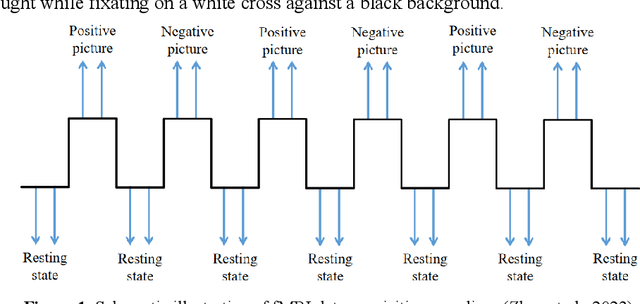


Abstract:Background: Although it has been noticed that depressed patients show differences in processing emotions, the precise neural modulation mechanisms of positive and negative emotions remain elusive. FMRI is a cutting-edge medical imaging technology renowned for its high spatial resolution and dynamic temporal information, making it particularly suitable for the neural dynamics of depression research. Methods: To address this gap, our study firstly leveraged fMRI to delineate activated regions associated with positive and negative emotions in healthy individuals, resulting in the creation of positive emotion atlas (PEA) and negative emotion atlas (NEA). Subsequently, we examined neuroimaging changes in depression patients using these atlases and evaluated their diagnostic performance based on machine learning. Results: Our findings demonstrate that the classification accuracy of depressed patients based on PEA and NEA exceeded 0.70, a notable improvement compared to the whole-brain atlases. Furthermore, ALFF analysis unveiled significant differences between depressed patients and healthy controls in eight functional clusters during the NEA, focusing on the left cuneus, cingulate gyrus, and superior parietal lobule. In contrast, the PEA revealed more pronounced differences across fifteen clusters, involving the right fusiform gyrus, parahippocampal gyrus, and inferior parietal lobule. Limitations: Due to the limited sample size and subtypes of depressed patients, the efficacy may need further validation in future. Conclusions: These findings emphasize the complex interplay between emotion modulation and depression, showcasing significant alterations in both PEA and NEA among depression patients. This research enhances our understanding of emotion modulation in depression, with implications for diagnosis and treatment evaluation.
 Add to Chrome
Add to Chrome Add to Firefox
Add to Firefox Add to Edge
Add to Edge